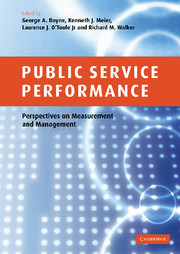Book contents
- Frontmatter
- Contents
- List of figures
- List of tables
- Notes on contributors
- 1 Introduction
- 2 Subjective and objective measures of organizational performance: An empirical exploration
- 3 All measures of performance are subjective: More evidence on US federal agencies
- 4 A qualitative evaluation of public sector organizations: Assessing organizational performance in healthcare
- 5 Quantitative approaches towards assessing organizational performance
- 6 Consequences of goal ambiguity in public organizations
- 7 Performance control and public organizations
- 8 Bureaucratic red tape and organizational performance: Testing the moderating role of culture and political support
- 9 All that glitters is not gold: Disaggregating networks and the impact on performance
- 10 Network evolution and performance under public contracting for mental health services
- 11 The design and management of performance-based contracts for public welfare services
- 12 Outsourcing government information technology services: An Australian case study
- 13 International comparisons of output and productivity in public service provision: A review
- 14 Public management and government performance: An international review
- 15 What drives global e-government? An exploratory assessment of existing e-government performance measures
- 16 Public management and organizational performance: An agenda for research
- Index
- References
11 - The design and management of performance-based contracts for public welfare services
Published online by Cambridge University Press: 22 September 2009
- Frontmatter
- Contents
- List of figures
- List of tables
- Notes on contributors
- 1 Introduction
- 2 Subjective and objective measures of organizational performance: An empirical exploration
- 3 All measures of performance are subjective: More evidence on US federal agencies
- 4 A qualitative evaluation of public sector organizations: Assessing organizational performance in healthcare
- 5 Quantitative approaches towards assessing organizational performance
- 6 Consequences of goal ambiguity in public organizations
- 7 Performance control and public organizations
- 8 Bureaucratic red tape and organizational performance: Testing the moderating role of culture and political support
- 9 All that glitters is not gold: Disaggregating networks and the impact on performance
- 10 Network evolution and performance under public contracting for mental health services
- 11 The design and management of performance-based contracts for public welfare services
- 12 Outsourcing government information technology services: An Australian case study
- 13 International comparisons of output and productivity in public service provision: A review
- 14 Public management and government performance: An international review
- 15 What drives global e-government? An exploratory assessment of existing e-government performance measures
- 16 Public management and organizational performance: An agenda for research
- Index
- References
Summary
Introduction
In the United States, the Wisconsin Works (W-2) programme is widely regarded as a pioneer in public welfare reform (Mead 2004). Beginning in 1997, Wisconsin made major changes in the administrative structures for the delivery of welfare services, ending the county government monopoly on public assistance administration and inviting private sector agencies to compete for contracts to manage local level programmes. Performance-based contracting was also introduced to motivate and monitor the performance of W-2 agencies by setting performance standards (and target levels) in advance and making payment and performance bonuses contingent on the achievement of performance goals.
Wisconsin is just one of many states that has increased contracting for public welfare services in the Temporary Assistance for Needy Families (TANF) programme. The US Government Accounting Office (GAO 2002) reported extensive contracting out for TANF services delivery in every state except one, with most funds (88 per cent) in state-level contracts (and close to three-fourths of these contracts with non-profit providers). The percentage of total TANF funds in contracts between states and for-profit providers ranged from 0–100 per cent in 2001; in addition, the majority of state funds were in traditional cost-reimbursement contracts (about 60 per cent); only about one-fifth of contracts included incentives to improve performance.
Designing performance-based contracts that align the interests of public and private providers with policy goals and effectively enforcing contract provisions are challenging tasks.
- Type
- Chapter
- Information
- Public Service PerformancePerspectives on Measurement and Management, pp. 189 - 211Publisher: Cambridge University PressPrint publication year: 2006
References
- 2
- Cited by



